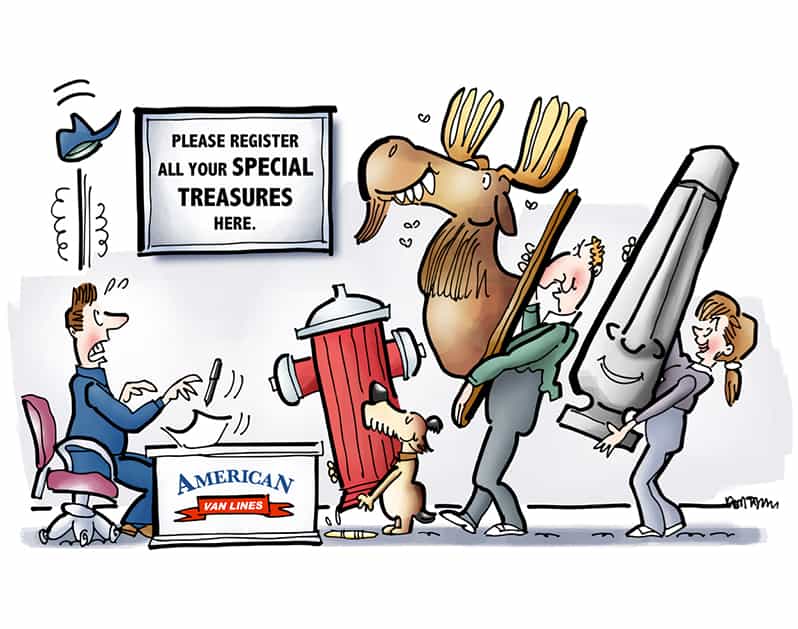
Say you’re walking along the beach one day, and you find a magic lamp. Out pops a genie who offers to grant you three wishes.
First you’d wish for a million dollars, right? Tax-free, of course. Then you’d wish for a lifetime supply of apple fritters— at least that’s what I’d do.
But for your third wish you’d say: “Please explain the difference between valuation coverage and moving insurance.”
Well, we can’t help you with the million bucks or the fritters, but you’re in luck on that third wish because that’s what today’s post is about!!
Valuation coverage and moving insurance both have to do with making sure you’re covered, liability-wise, if any of your household goods are lost or damaged during a move.
At American Van Lines we do all we can to make sure that doesn’t happen. If it does, we want to be sure you have adequate coverage so you can be properly compensated.
“Valuation” is the perceived value of your goods— how much you think they’re worth. More specifically: their replacement value. How much would it cost to replace everything if all your goods were lost during a move?
Federal law requires interstate movers like American Van Lines to offer customers valuation coverage. Movers have to assume liability for the goods they’re transporting. Valuation coverage is similar to insurance (it’s a form of liability coverage), but it’s not the same as insurance.
Valuation coverage is less comprehensive than insurance: it doesn’t cover things outside a mover’s control: a hurricane, for example. With valuation coverage, movers are only responsible for any loss or damage they cause during a move.
By contrast, you can purchase third-party moving insurance that will cover fire and natural disasters like earthquakes and hurricanes. That is, in fact, what we recommend here at American Van Lines.
Let’s look at the options for liability coverage when you’re moving. There are three options.
1. Full Value Protection (FVP)
FVP is an additional cost beyond the cost of transporting your goods.
It’s also the default option for liability coverage when you move.
Moving companies require you to have a certain minimum amount of Full Value Protection. Here at American Van Lines we require a minimum of $6 per pound. If we weigh your goods and the total weight is 10,000 pounds, we require you to have $60,000 worth of FVP coverage for your goods.
You can also choose a deductible which will lower the cost of the coverage.
To put that in perspective: assume you buy $60,000 worth of coverage with a $500 deductible. Now assume the worst: the driver misses a turn en route. The van goes over a cliff, and you lose everything. As compensation, you’d receive $59,500: $60,000 minus the $500 deductible.
Can you buy more coverage than the $6 per pound minimum? Absolutely. And it doesn’t have to be by weight. You could carefully inventory all your goods and name an assessed value: “I think my goods are worth $100,000. That’s how much I think it would cost to replace everything, and that’s the amount of coverage I want to buy.”
Chances are, you own some items that are worth a lot of money. In the moving business, those are called Items of Extraordinary Value. The technical definition: items that are worth more than $100 per pound. Maybe a lot more. Examples: artwork, china, antiques.
Very important point: those items are not just lumped in with everything else when you buy Full Value Protection. You have to identify items of extraordinary value, and you have to declare those items on your extraordinary value inventory. You also have to pay an additional premium to cover those items because of their exceptional value.
Repeat: you have to declare those items on your extraordinary value inventory. Per federal law, if you fail to declare such items, the mover cannot be held liable for their loss or damage.
Another very important point: FVP does not cover anything you’ve packed yourself– what are called PBO boxes (= Packed By Owner). Since the mover is assuming liability, the mover has to be sure items are packed with the proper care. The big problem with a PBO box: there’s no way to know what condition the items were in prior to being packed or whether they had some prior damage. For that reason, FVP only covers CP boxes (= Company Packed).
You’ll also forfeit your FVP coverage if you pack hazardous materials without your mover’s knowledge (it’s also illegal). Examples: paints, gasoline, fireworks, propane cylinders.
In the event of a loss under FVP, the moving company can choose one of three options, and it’s their choice: 1) repair the item 2) replace the item with one of comparable value 3) pay you the market value of the item (e.g., the value of a three-year-old sofa, as opposed to a brand-new sofa).
A related and important point: FVP does not include coverage for pairs or matching sets. For example: if you have a living room set (a sofa and two armchairs), and one of the chairs is damaged beyond repair during a move, the mover is only obliged to replace the chair with one of comparable value— and it might not be able to find a chair that matches the other two pieces.
2. Released Value Protection (RVP)
As mentioned above, FVP is the default liability coverage when you move. You can, however, decline it and opt for Released Value Protection instead.
Released Value Protection is free (no extra charge to you), and there are no deductibles.
Under RVP, a mover will not repair or replace a lost or damaged item. Compensation is strictly monetary, and protection is minimal: in case of loss or damage, you’d be compensated at a rate of $0.60 per pound, per item. Which means you could take a big loss on an expensive item that doesn’t weigh that much.
Easy example: that 75” 4K QLED flat-screen television you bought for $2600. Say it weighs 30 pounds. If it were shattered during a move, and you only had RVP, your total compensation would be $0.60 x 30 = $18.
Given the fact that it offers very little protection, does opting for RVP ever make sense?
It might— if you don’t own anything of great value. Say you’re a new grad, and you’re relocating to take a job. The only things of value are your phone and your laptop. You could transport those things yourself in your car. If your 100-lb secondhand kitchen table got scratched during the move, you’d receive $60 ($0.60 x 100)— which might be enough to repair the scratch.
Worth repeating: because RVP offers only minimal protection, you have to specifically request it. The default liability coverage when you move is FVP (Full Value Protection).
American Van Lines can provide you with FVP or RVP, but we recommend the third liability coverage option: third-party moving insurance.
3. Third-Party Moving Insurance
Before buying third-party moving insurance, check your current homeowners policy and/or check with your agent. Find out what your policy covers. Odds are it won’t cover your goods while they’re in transit, but find out if it offers any coverage during a move. Be sure to ask what additional coverage you will need.
American Van Lines recommends Baker International for moving insurance. You can obtain a policy through their website, or call their sales department at 1-800-356-0093.
Note: you will need to know two things in order to buy moving insurance: your moving company’s ID number, and the total weight of your shipment.
Very, very important: If you buy moving insurance, be sure you know what’s included, and what isn’t. If you want pairs and matching sets coverage, for example, make sure it’s included in the policy.
Also: Make sure your goods are covered during each stage of the move: packing, loading onto the truck, in transit, and being unloaded and carried into your new residence.
Take the time to properly assess your goods and insure them for 100% of their value. If you insure them for less and suffer a loss, you could face significant out-of-pocket costs.
Which brings us to an important insurance concept you need to understand: coinsurance.
Coinsurance
Most insurance policies that cover property, including moving and relocation policies, include a coinsurance clause. It means you’re sharing some of the risk with the insurance company.
If you elect to underinsure a specific item (not insure it for its full value), you’re electing to assume more of the risk— and you’ll be stuck with more of the cost if the item is lost or damaged.
Why would someone underinsure an item and skimp on coverage? To save money: you’ll pay a smaller premium if you buy less coverage than you really need.
A simple example shows why that’s a bad idea:
Suppose you own a 3-piece entertainment center, complete with storage bookcases. It’s worth $4000. You decide to take a chance and insure it for only $2000 so you can pay less premium. Your moving insurance policy has a $500 deductible and contains a coinsurance clause.
During the move, the unit is badly damaged. It will cost $1200 to repair it. You file a claim for that amount.
The insurance company notes that you only insured the unit for half its value. Which means the insurance company is only responsible for 50% of the loss: 0.50 x $1200 = $600. They subtract out your $500 deductible and pay you $100.
If you had insured the unit for its full value, the insurance company would have paid you $1200 minus your $500 deductible = $700.
Confused? Worried? Anxious about any of this?
Please don’t be any of those things. Because here’s the bottom line: American Van Lines wants your move to be successful, and we’re going to do all we can to make sure it’s completely satisfactory.
We’ve written this post to give you (we hope!) a better understanding of valuation coverage and moving insurance. So you can ask questions that need to be asked. Knowledge is power. If you know how things work, you can proceed with confidence. No surprises.
Questions? Please give us a call. That’s what we’re here for. At American Van Lines we partner with our customers to make sure they have the best possible moving experience.

Mark Armstrong is an illustrator and digital marketing expert. He helps brands get noticed and tell their stories. He knows humor gets people to lower their shields.






